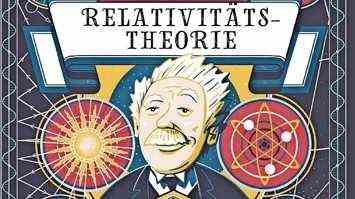The perfect scene in a science fiction film: a 200-meter-long train rushes into a 50-meter-long tunnel at almost the speed of light – and disappears completely into it. The funny idea of a scriptwriter? No, hard physics! This complex phenomenon is called relativistic length contraction. It follows from a theory that Albert Einstein developed more than a century ago. Who else? One would like to ask, because the scientist is not only the epitome of genius, but also a master of the absurd. He revolutionized the physical worldview and at the same time managed to fascinate people with knowledge that they basically do not understand. Einstein was well aware of this and so he tried to describe his ideas and their consequences in an understandable way in lectures and books. He used thought experiments that also helped him in his research. Since then, countless authors have worked on the theory of relativity, more or less successfully.
Albert Einstein would certainly have liked the book that the journalist Carl Wilkinson and the illustrator James Weston Lewis present for young readers. Using large-format double-sided illustrations, the congenial duo explains the special and general theory of relativity on each completed topic. In addition, milestones from Einstein’s biography are continually incorporated and complete the individual bits of knowledge to form an overall picture of the great physicist.
Right at the beginning, Wilkinson skilfully describes the fundamental concepts of “gravity”, “time”, “space” or “light” and their traditional interpretations, which go back to scientists like Isaac Newton and which are part of ancient physics.
In his theory of relativity, Einstein formulated the first pillars of his new physics
In contrast to this, the author then designs the architecture of Einstein’s world building step by step, starting with the term relativity and the miracle year 1905, in which the then employee at the Bern patent office presented four groundbreaking works. For one of them, which incidentally had nothing to do with the theory of relativity, he was awarded the Nobel Prize for 1921.
In his special theory of relativity, which contradicts everything that scientists and thinkers had previously believed, Einstein formulated the first pillar of his new physics. Space and time are inseparably interwoven, the speed of light is always constant and mass and energy can be converted into one another according to the most famous formula of all time: E = mc². Strange things such as the aforementioned contraction in length or the twin paradox are based on the special theory of relativity, according to which an astronaut who moves through space in his rocket at almost the speed of light ages much more slowly than his twin sister who has remained on earth.
With these physical peculiarities and also with the main features of the general theory of relativity, with black holes and gravitational waves, Wilkinson familiarizes himself in a profound way. The benefits of the theory, for example for GPS navigation systems and lasers (the fiber optic cables mentioned have nothing to do with Einstein) and a look at the future of physics are at the end of the book. Recommended all round? Yes, but with one caveat: Because of the appealing look, the first leafing through gives the impression that you can just immerse yourself in Einstein’s world and understand everything straight away without any problems. In fact, despite the short blocks of text and the successful illustrations, the book makes high demands on concentration and imagination. But it definitely provides the basis for your own thought experiments (from 14 years)

